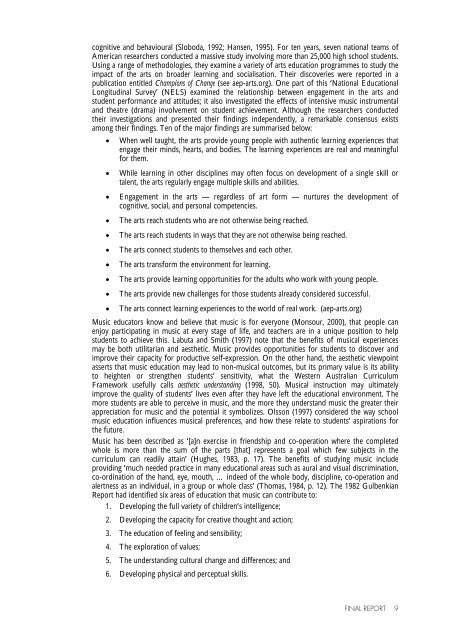National Review of School Music Education - Murdoch Research ...
National Review of School Music Education - Murdoch Research ...
National Review of School Music Education - Murdoch Research ...
You also want an ePaper? Increase the reach of your titles
YUMPU automatically turns print PDFs into web optimized ePapers that Google loves.
cognitive and behavioural (Sloboda, 1992; Hansen, 1995). For ten years, seven national teams <strong>of</strong><br />
American researchers conducted a massive study involving more than 25,000 high school students.<br />
Using a range <strong>of</strong> methodologies, they examine a variety <strong>of</strong> arts education programmes to study the<br />
impact <strong>of</strong> the arts on broader learning and socialisation. Their discoveries were reported in a<br />
publication entitled Champions <strong>of</strong> Change (see aep-arts.org). One part <strong>of</strong> this ‘<strong>National</strong> <strong>Education</strong>al<br />
Longitudinal Survey’ (NELS) examined the relationship between engagement in the arts and<br />
student performance and attitudes; it also investigated the effects <strong>of</strong> intensive music instrumental<br />
and theatre (drama) involvement on student achievement. Although the researchers conducted<br />
their investigations and presented their findings independently, a remarkable consensus exists<br />
among their findings. Ten <strong>of</strong> the major findings are summarised below:<br />
• When well taught, the arts provide young people with authentic learning experiences that<br />
engage their minds, hearts, and bodies. The learning experiences are real and meaningful<br />
for them.<br />
• While learning in other disciplines may <strong>of</strong>ten focus on development <strong>of</strong> a single skill or<br />
talent, the arts regularly engage multiple skills and abilities.<br />
• Engagement in the arts — regardless <strong>of</strong> art form — nurtures the development <strong>of</strong><br />
cognitive, social, and personal competencies.<br />
• The arts reach students who are not otherwise being reached.<br />
• The arts reach students in ways that they are not otherwise being reached.<br />
• The arts connect students to themselves and each other.<br />
• The arts transform the environment for learning.<br />
• The arts provide learning opportunities for the adults who work with young people.<br />
• The arts provide new challenges for those students already considered successful.<br />
• The arts connect learning experiences to the world <strong>of</strong> real work. (aep-arts.org)<br />
<strong>Music</strong> educators know and believe that music is for everyone (Monsour, 2000), that people can<br />
enjoy participating in music at every stage <strong>of</strong> life, and teachers are in a unique position to help<br />
students to achieve this. Labuta and Smith (1997) note that the benefits <strong>of</strong> musical experiences<br />
may be both utilitarian and aesthetic. <strong>Music</strong> provides opportunities for students to discover and<br />
improve their capacity for productive self-expression. On the other hand, the aesthetic viewpoint<br />
asserts that music education may lead to non-musical outcomes, but its primary value is its ability<br />
to heighten or strengthen students’ sensitivity, what the Western Australian Curriculum<br />
Framework usefully calls aesthetic understanding (1998, 50). <strong>Music</strong>al instruction may ultimately<br />
improve the quality <strong>of</strong> students’ lives even after they have left the educational environment. The<br />
more students are able to perceive in music, and the more they understand music the greater their<br />
appreciation for music and the potential it symbolizes. Olsson (1997) considered the way school<br />
music education influences musical preferences, and how these relate to students’ aspirations for<br />
the future.<br />
<strong>Music</strong> has been described as ‘[a]n exercise in friendship and co-operation where the completed<br />
whole is more than the sum <strong>of</strong> the parts [that] represents a goal which few subjects in the<br />
curriculum can readily attain’ (Hughes, 1983, p. 17). The benefits <strong>of</strong> studying music include<br />
providing ‘much needed practice in many educational areas such as aural and visual discrimination,<br />
co-ordination <strong>of</strong> the hand, eye, mouth, … indeed <strong>of</strong> the whole body, discipline, co-operation and<br />
alertness as an individual, in a group or whole class’ (Thomas, 1984, p. 12). The 1982 Gulbenkian<br />
Report had identified six areas <strong>of</strong> education that music can contribute to:<br />
1. Developing the full variety <strong>of</strong> children’s intelligence;<br />
2. Developing the capacity for creative thought and action;<br />
3. The education <strong>of</strong> feeling and sensibility;<br />
4. The exploration <strong>of</strong> values;<br />
5. The understanding cultural change and differences; and<br />
6. Developing physical and perceptual skills.<br />
FINAL REPORT 9
















